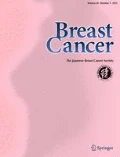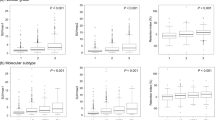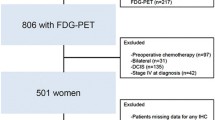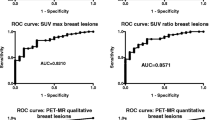Abstract
Background: Positron emission tomography (PET) is a non-invasive imaging modality used in the diagnosis and staging of breast cancer. However, several factors can affect fluoro-deoxyglucose (FDG) uptake by a tumor. To clarify the parameters that most affect FDG accumulation in tumors, the relationship between standardized uptake values (SUVs) and clinicopathological factors and immunohistopatho-logical analysis was investigated in breast cancer.
Material and Methods: PET studies were performed preoperatively on 37 patients with breast carcinoma. SUVs were counted at one hour (early phase) and at two hours (delayed phase) after FDG injection. The relationships between SUVs and 13 clinical, pathological and immunohistchemical factors were studied.
Results: A significant association was found between FDG accumulation and early and delayed phase mitotic counts (p = 0.0018 and 0.0010, respectively), Ki67 positive cell percentage (p = 0.0098 and 0.0062, respectively), and nuclear grade (p = 0.0232 and 0.0195, respectively). On the other hand, nodal status weakly correlated with the delayed phase (p = 0.0907). However, other clinicopathological parameters and immunohistopathological status, which included tumor size, age, histology, estrogen receptor, progesterone receptor and Her2/neu overexpression, did not correlate significantly with FDG uptake.
Conclusion: Mitotic count and Ki67 reflect cellular aggressiveness. These parameters were strongly correlated with tracer uptake. Thus our data suggested that the biological behavior of breast cancer is reflected in the variation of FDG uptake by the tumor. However, whether FDG uptake is a true prognostic and predictive factor remains to be confirmed in larger studies over an extended period of time.
Similar content being viewed by others
Abbreviations
- PET:
-
Positron emission tomography
- FDG:
-
Fluoro-deoxyglucose
- SUV:
-
Standardized uptake value
References
Wahl RL, Cody RL, Hutchins GD, Mudgett EE: Primary and metastatic breast carcinoma: initial clinical evaluation with PET with the radiolabeled glucose analogue 2-[F-18]-fluoro-2-deoxy-D-glucose.Radiology 179:765–770, 1991.
Tse NY, Hoh CK, Hawkins RA, Zinner MJ, Dahlbom M, Choi Y, Maddahi J, Brunicaridi FC, Phelps ME, Glaspy JA: The application of positron emission tomo- graphic imaging with fluorodeoxyglucose to the evaluation of breast disease.Ann Surg 216:27–34, 1992.
Nieweg OE, Kim EE, Wong WH, Broussard WF, Singletary SE, Hortobagyi GN, Tilbury RS: Positron emission tomography with fluorine-18-deoxyglucose in the detection and staging of breast cancer.Cancer 71:3920–3925, 1993
Adler LP, Crowe JP, al-Kaisi NK, Sunshine JL: Evaluation of breast masses and axillary lymph nodes with [F-18] 2-deoxy-2-fluoro-D-glucose PET.Radiology 187:743–750,1993.
Bruce DM, Evans NTS, Heys SD, Needham G, BenYounes H, Mikecz P, Smith FW, Sharp F, Eremin O: Positron emission tomography: 2-deoxy-2-[18F]-fluoro-D-glucose uptake in locally advanced breast cancers.EurJ Surg Oncol 21:280–283, 1995.
Avril N, Dose J, Janicke F, Benese S, Ziegler S, Laubenbacher C, Romer W, Pache H, Herz M, Allgayer B, Nathrath W, Graeff H, Schwaiger M: Metabolic characterization of breast tumours with positron emission tomography using F-18 fluorodeoxyglucose.J Clin Oncol 14:1848–1857, 1996.
Utech CI, Young CS, Winter PF: Prospective evaluation of fluorine-18 fluorodeoxyglucose positron emission tomography in breast cancer for staging of the axilla related to surgery and immunocytochemistry.Eur J Nucl Med 23:1588–1593, 1996.
Scheidhauer K, Scharl A, Pietrzyk U, Wagner R, Gohring UJ, Schomacher K, Schicha H: Qualitative [18F]FDG positron emission tomography in primary breast cancer: clinical relevance and practicability.Eur J Nucl Med 23:618–623, 1996.
Avril N, Dose J, Janicke F, Ziegler S, Romer W, Weber W, Herz M, Nathrath W, Graeff H, Schwaiger M: Assessment of axillary lymph node involvement in breast cancer patients with positron emission tomography using radiolabeled 2-(fluorine-18)fluoro-2-deoxy-D-glucose.J Natl Cancer Inst 88:1204–1209, 1996.
Crippa F, Agrest R, Seregni E, Greco M, Pascali C, Bogni A, Chiesa C, DeSanctis V, Delledonne V, Savadori B, Leutner M, Bombardiert E: Prospective evaluation of [18F]FDG positron emission tomography (PET) in the presurgical staging of the axilla in breast cancer: comparison between PET and postoperative pathology.J Nucl Med 39:4–8, 1998.
Folpe AL, Lyles RH, Sprouse JT, Conrad EU, Eary JF: F-18 fluorodeoxyglucose positron emission tomography as a predictor of pathologic grade and other prognostic variables in bone and soft tissue sarcoma.Clin Cancer Res 4:1279–1287, 2000.
Brock CS, Meikle SR, Price P: Does fluorine-18 fluorodeoxyglucose metabolic imaging of tumours benefit oncology?Eur J Nucl Med 24:691–705, 1997.
Eberlein TJ: Current management of carcinoma of the breast.Ann Surg 2:121–136, 1994.
Schomburg A, Bender H, Reichel C: Standardized uptake values of fluorine-18 fluorodeoxy glucose: the value of different normalization procedures.Eur J Nucl Med 23:571–574, 1996.
Sakamoto G, Inaji H, Akiyama F, Haga S, Hiraoka M, Inai K, Iwase T, Kobayashi S, Sano M, Sato T, Sonoo H, Tsuchiya S, Watanabe T: The Japanese Breast Cancer Society. General rules for clinical and pathological recording of breast cancer 2005.Breast Cancer 12 Suppl: 1–27, 2005.
Tsuda H, Akiyama F, Kuroisumi M, Sakamoto G, Watanabe T: Establishment of histological criteria for high-risk node-negative breast carcinoma for a multi-institutional randomized clinical trial of aduvant therapy.Jpn J Clin Oncol 28:486–491, 1998.
Bankfalv A, Boecker W, Reiner A: Comparison of automated and manual determination of HER2 status in breast cancer for diagnostic use: a comparative methodological study using the Ventana BenchMark automated staining system and manual tests.Int J Oncol 25:929–935, 2004.
Hayashi M, Okabe T, Sano M, Honma K: Comparing immunohistochemistry to enzyme immuno assays for estrogen receptor and progesterone receptor status.Jpn J Breast Cancer 17:306–310, 2002 (in Japanese with English abstract).
Bilous M, Dowsett M, Hanna W, Isola J, Lebeau A, Moreno A, Penault-Llorca F, Ruschoff J, Tomasic G, van de Vijver M: Current perspectives on HER2 testing: a review of national testing guidelines.Mod Pathol 16:173–182, 2003.
Higashi K, Clavo AC, Wahl R: Does FDG uptake measure proliferative activity of human cancer cells? In vitro comparison with DNA flow cytometry and tritiated thymidine uptake.J Nucl Med 34:414–419, 1993.
Kubota K, Yamada S: FDG accumulation in tumour tissue.J Nucl Med 34:419–421, 1993.
Higashi T, Tamaki N, Torizuka T, Nakamoto Y, Sakahara H, Kimura T, Honda T, Inokuma T, Katsushima S, Ohshio G, Imamura M, Konishi J: FDG uptake, GLUT-1 glucose transporter and cellularity in human pancreas tumors.J Nucl Med 39:1727–1735, 1998.
Kato T, Fukatsu H, Ito K, Tadokoro M, Ota T, Ikeda M, Isomura T, Ito S, Nishino M, Ishigaki T: Fluorodeoxyglucose positron emission tomography in pancreatic cancer: an unsolved problem.Eur J Nucl Med 22:32–39, 1995.
Dehdashti F, Mortimer JE, Siegel BA, Griffeth LK, Bonasera TJ, Fusselman MJ, Detert DD, Cutler PD, Katzenellenbogen JA, Welch MJ: Positron tomographic assessment of estrogen receptors in breast cancer: a comparison with FDG-PET andin vitro receptor assays.J Nucl Med 36:1766–1774, 1995.
Andre F, Pusztai L: Molecular classification of breast cancer: implications for selection of adjuvant chemotherapy.Nat Clin Pract Oncol 11:621–632, 2006.
Sloka S, Hollett D, Mathews M: Cost-effectiveness of positron emission tomography in breast cancer.Mol Imaging Biol 7:351–360, 2005.
Author information
Authors and Affiliations
Corresponding author
About this article
Cite this article
Shimoda, W., Hayashi, M., Murakami, K. et al. The relationship between FDG uptake in PET scans and biological behavior in breast cancer. Breast Cancer 14, 260–268 (2007). https://doi.org/10.2325/jbcs.14.260
Received:
Accepted:
Issue Date:
DOI: https://doi.org/10.2325/jbcs.14.260




